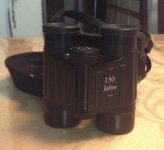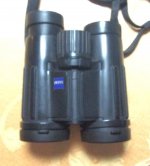From Dialyt to SF, the aesthetics of Zeiss binoculars have evolved with several ‘diversions’ down a variety of different avenues along the way. I thought it would be entertaining to take a stroll down a few of these diversions to compare and contrast various models, and also have a few brief glimpses into the design process. The first decision was which models to leave out, and in deference to the way the market has developed, I have concentrated on roof prism binoculars with rubber armour. I apologise to those whose favourites might lie outside of this and just remark here that I am similarly placed as I really love the old leatherette Dialyts. This overview covers 7 models from the Dialyt 7x42 BGAT* to FL 8x42, so here we go…
Dialyt 7x42BGAT*
Zeiss’s famous Dialyt 7x42 was born out of Hensoldt’s Dialyt range, following Zeiss’s takeover of the Wetzlar-based company. This range was more diverse than Zeiss’s later offerings,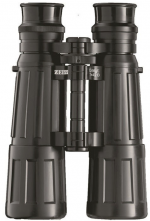 for example Hensoldt made this model in 8x30 and 10x50 as well as 7x42. Zeiss developed the model further into the one we are familiar with today. It had the look of two telescopes side by side, had the exposed bridges and axle reminiscent of a Porro binocular, and like those, the centre focus wheel actually moved the eyepieces rather than in internal lens. Foldable rubber eyecups marked this model out as spectacle-friendly, but the biggest visual impact was made by the chunky rubber armour embellished with prominent rubber bars that presented a stout, robust appearance. As an aside it is interesting, looking back with hindsight, that this model’s performance was the inspiration for the original Swarovski EL.
for example Hensoldt made this model in 8x30 and 10x50 as well as 7x42. Zeiss developed the model further into the one we are familiar with today. It had the look of two telescopes side by side, had the exposed bridges and axle reminiscent of a Porro binocular, and like those, the centre focus wheel actually moved the eyepieces rather than in internal lens. Foldable rubber eyecups marked this model out as spectacle-friendly, but the biggest visual impact was made by the chunky rubber armour embellished with prominent rubber bars that presented a stout, robust appearance. As an aside it is interesting, looking back with hindsight, that this model’s performance was the inspiration for the original Swarovski EL.
Dialyt 10x40BGAT*P*
Here we see an entirely different concept of design. Instead of the bridges and axle being exposed as on the 7x42, they are now hidden, so instead of looking like two telescopes joined side-by-side, the appearance is of a more modern, unified single structure. However it shares the same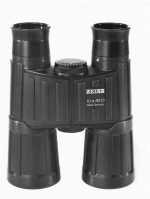 armour design with the 7x42 BGAT* having the rugged rubber bars that endow it with a robust appearance.
armour design with the 7x42 BGAT* having the rugged rubber bars that endow it with a robust appearance.
Design Selection 8x56
This model could not be more different from the Dialyts. Its smooth armour, and the way the oculars and objectives are integrated into the overall shape,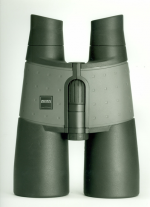 speak of the principals of aerodynamics having inspired those who created its appearance. Even the end of the focus wheel nearest the eyepieces is rounded like a streamlined nacelle on an aircraft, and, at the expense of practicality, it barely protrudes above the surrounding surfaces. The pattern of small marks on the grip-area of the armour are in fact miniature versions of Zeiss’s famous Z logo. Also, note the semi-winged foldable eyecups that were simultaneously a touch of styling modernity and functionality, as they screened the eyes from distracting side-lighting.
speak of the principals of aerodynamics having inspired those who created its appearance. Even the end of the focus wheel nearest the eyepieces is rounded like a streamlined nacelle on an aircraft, and, at the expense of practicality, it barely protrudes above the surrounding surfaces. The pattern of small marks on the grip-area of the armour are in fact miniature versions of Zeiss’s famous Z logo. Also, note the semi-winged foldable eyecups that were simultaneously a touch of styling modernity and functionality, as they screened the eyes from distracting side-lighting.
Victory 8x56
The big-objectives Victory models took the Design Selection look and sobered it up with more conventional eyecups and slightly more practical focus and dioptre wheels. There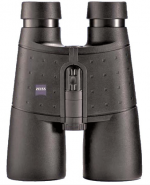 was no hint of the iconoclastic style of the 40mm models (see below).
was no hint of the iconoclastic style of the 40mm models (see below).
Victory 8x40
The 40mm versions of the first models to carry the Victory name took modernity to another level. Compare this to the Dialyt 10x40BGAT*P* above, and while that model had clear hints back to earlier models, this one looked as though it had landed from outer space. It challenged the eye with swooping, curvaceous feature-lines and provocatively-angled eyecups, combined with a chunky focus wheel having streamlined ridges to aid grip, similar to those on Diafun . However, compared with Diafun, the first Victory was almost conventional with its obvious and undisguised objectives.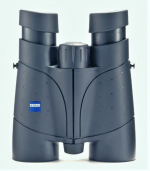
Diafun 8x30, 10x30
This model took the concept of a binocular not looking like a binocular to an extreme, at least below the focus wheel. The eyecups and focus wheel/dioptre wheel looked reasonably normal, although the slanted, semi-winged, eyecups were a little unconventional. However down at the objectives, the lenses had disappeared, disguised by the extended body and full-length closed hinge. On some units blue highlights were applied to the eyecups and also around the objectives, giving the latter a kind of ‘Elton John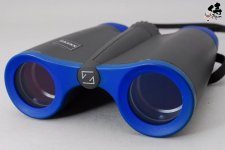 ’s sunglasses’-appe
’s sunglasses’-appe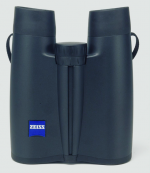 arance (see below).
arance (see below).
Victory FL 8x42
The first Victory was not a success and it seems when replacing it with the Victory FL, Zeiss took a step back from the space-age, and not only reverted to more conventional eyecups but also deleted the swooping feature-lines, and went at least part-way back to the Dialyt-look by adorning the armour on the optical tubes with prominent rubber bars, and furnished the moulded focus wheel with straight-sided grip-bars, echoing the bars of the armour.
Production Dates with Grateful Thanks to Gary MH:
7x42 Dialyt 1981-1988
7x42 Dialyt P 1988-2004
10x40 B Dialyt (524020) 1968-1977]
10x40 B Dialyt (524021) 1977-1980
10x40 B Dialyt (524010) 1983-1988
10x40 B Dialyt P (524012) 1988-1996
10x40 B Dialyt P / BGA (424013) 1988-2005
7x45, 8/10x56 Night Owl/Design Selection 1993-2000
8x56/10/12x56 Victory Mk.1 2001-2006
8/10x40 Victory Mk.1 2000-2004
Diafun 1997-2003
Production Date Researched by Troubador (corrections gratefully received)
FL 8x42 2004-2012
Part 2 follows shortly and will bring us up to date.
Lee
Dialyt 7x42BGAT*
Zeiss’s famous Dialyt 7x42 was born out of Hensoldt’s Dialyt range, following Zeiss’s takeover of the Wetzlar-based company. This range was more diverse than Zeiss’s later offerings,
 for example Hensoldt made this model in 8x30 and 10x50 as well as 7x42. Zeiss developed the model further into the one we are familiar with today. It had the look of two telescopes side by side, had the exposed bridges and axle reminiscent of a Porro binocular, and like those, the centre focus wheel actually moved the eyepieces rather than in internal lens. Foldable rubber eyecups marked this model out as spectacle-friendly, but the biggest visual impact was made by the chunky rubber armour embellished with prominent rubber bars that presented a stout, robust appearance. As an aside it is interesting, looking back with hindsight, that this model’s performance was the inspiration for the original Swarovski EL.
for example Hensoldt made this model in 8x30 and 10x50 as well as 7x42. Zeiss developed the model further into the one we are familiar with today. It had the look of two telescopes side by side, had the exposed bridges and axle reminiscent of a Porro binocular, and like those, the centre focus wheel actually moved the eyepieces rather than in internal lens. Foldable rubber eyecups marked this model out as spectacle-friendly, but the biggest visual impact was made by the chunky rubber armour embellished with prominent rubber bars that presented a stout, robust appearance. As an aside it is interesting, looking back with hindsight, that this model’s performance was the inspiration for the original Swarovski EL.Dialyt 10x40BGAT*P*
Here we see an entirely different concept of design. Instead of the bridges and axle being exposed as on the 7x42, they are now hidden, so instead of looking like two telescopes joined side-by-side, the appearance is of a more modern, unified single structure. However it shares the same
 armour design with the 7x42 BGAT* having the rugged rubber bars that endow it with a robust appearance.
armour design with the 7x42 BGAT* having the rugged rubber bars that endow it with a robust appearance.Design Selection 8x56
This model could not be more different from the Dialyts. Its smooth armour, and the way the oculars and objectives are integrated into the overall shape,
 speak of the principals of aerodynamics having inspired those who created its appearance. Even the end of the focus wheel nearest the eyepieces is rounded like a streamlined nacelle on an aircraft, and, at the expense of practicality, it barely protrudes above the surrounding surfaces. The pattern of small marks on the grip-area of the armour are in fact miniature versions of Zeiss’s famous Z logo. Also, note the semi-winged foldable eyecups that were simultaneously a touch of styling modernity and functionality, as they screened the eyes from distracting side-lighting.
speak of the principals of aerodynamics having inspired those who created its appearance. Even the end of the focus wheel nearest the eyepieces is rounded like a streamlined nacelle on an aircraft, and, at the expense of practicality, it barely protrudes above the surrounding surfaces. The pattern of small marks on the grip-area of the armour are in fact miniature versions of Zeiss’s famous Z logo. Also, note the semi-winged foldable eyecups that were simultaneously a touch of styling modernity and functionality, as they screened the eyes from distracting side-lighting.Victory 8x56
The big-objectives Victory models took the Design Selection look and sobered it up with more conventional eyecups and slightly more practical focus and dioptre wheels. There
 was no hint of the iconoclastic style of the 40mm models (see below).
was no hint of the iconoclastic style of the 40mm models (see below).Victory 8x40
The 40mm versions of the first models to carry the Victory name took modernity to another level. Compare this to the Dialyt 10x40BGAT*P* above, and while that model had clear hints back to earlier models, this one looked as though it had landed from outer space. It challenged the eye with swooping, curvaceous feature-lines and provocatively-angled eyecups, combined with a chunky focus wheel having streamlined ridges to aid grip, similar to those on Diafun . However, compared with Diafun, the first Victory was almost conventional with its obvious and undisguised objectives.

Diafun 8x30, 10x30
This model took the concept of a binocular not looking like a binocular to an extreme, at least below the focus wheel. The eyecups and focus wheel/dioptre wheel looked reasonably normal, although the slanted, semi-winged, eyecups were a little unconventional. However down at the objectives, the lenses had disappeared, disguised by the extended body and full-length closed hinge. On some units blue highlights were applied to the eyecups and also around the objectives, giving the latter a kind of ‘Elton John
 ’s sunglasses’-appe
’s sunglasses’-appe arance (see below).
arance (see below).Victory FL 8x42
The first Victory was not a success and it seems when replacing it with the Victory FL, Zeiss took a step back from the space-age, and not only reverted to more conventional eyecups but also deleted the swooping feature-lines, and went at least part-way back to the Dialyt-look by adorning the armour on the optical tubes with prominent rubber bars, and furnished the moulded focus wheel with straight-sided grip-bars, echoing the bars of the armour.

Production Dates with Grateful Thanks to Gary MH:
7x42 Dialyt 1981-1988
7x42 Dialyt P 1988-2004
10x40 B Dialyt (524020) 1968-1977]
10x40 B Dialyt (524021) 1977-1980
10x40 B Dialyt (524010) 1983-1988
10x40 B Dialyt P (524012) 1988-1996
10x40 B Dialyt P / BGA (424013) 1988-2005
7x45, 8/10x56 Night Owl/Design Selection 1993-2000
8x56/10/12x56 Victory Mk.1 2001-2006
8/10x40 Victory Mk.1 2000-2004
Diafun 1997-2003
Production Date Researched by Troubador (corrections gratefully received)
FL 8x42 2004-2012
Part 2 follows shortly and will bring us up to date.
Lee
Last edited:






